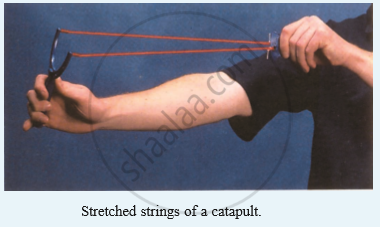Advertisements
Advertisements
प्रश्न
A ball falls to the ground as shown below :
What is the potential energy of ball at B?
उत्तर
Total energy of a free falling object remains conserved.
So,
Total energy at A = Total energy at B
So,
(K.E)A + (P.E)A = (K.E)B + (P.E)B
Thus
Total energy at A = (K.E)B + (P.E)B
Therefore,
(P.E)B = (80 – 48) J= 32 J
APPEARS IN
संबंधित प्रश्न
A ball of mass 0.20 kg is thrown vertically upwards with an initial velocity of 20 m s-1. Calculate the maximum potential energy it gains as it goes up.
Is energy a vector quantity?
State whether the object possess kinetic energy, potential energy, or both :
A man climbing a hill _____________.
What type of energy is possessed : by the piece of stone which is thrown away on releasing the stretched rubber strings of catapult?
Name the device or machine which convert :
Chemical energy into electrical energy.
A bulb lights up when connected to a battery. State the energy change which takes place :
The hanging bob of a simple pendulum is displaced to one extreme position B and then released. It swings towards centre position A and then to the other extreme position C. In which position does the bob have :
(i) maximum potential energy?
(ii) maximum kinetic energy?
Explain the transformation of energy in the following cases :
(i) A ball thrown upwards.
(ii) A stone dropped from the roof of a building.
Name the energy transfers which occur when : a torch is on
Which of the following energy change involves frictional force?
